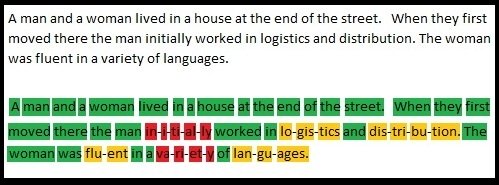Reading Fluency
Stop Guessing Unfamiliar Words!!!
Smooth reading fluency depends on both recognising familiar words from memory and decoding the unknown ones sound by sound. Dyslexic people can have a wide range of problems that disrupt comprehension.
Guessing unknown words is a common symptom of dyslexia. We need to put a stop to this. This page will show you how to read without having to guess any unfamiliar words.
Memory and Decoding:
We read words either from memory or by decoding them. With simple text we are usually just reading the words from memory. For example, most people can read the word 'cat' just by looking at it. There is no need to break it down sound by sound. Therefore most people read the word ‘cat’ from memory.
However when it comes to less familiar words like for example, ‘accommodation’ it may be necessary to break it down and sound it out, ‘ac,-com,-mo,-da,-tion. The fancy name for this process is called decoding.
Problems encountered by dyslexic people:
When a dyslexic person is reading a variety of problems can occur:- Reading too quickly and incorrectly guessing unknown words. This disrupts comprehension.
- Getting stuck on unfamiliar words. This is known as fixation. The reader is trying to remember the unfamiliar word rather than decode it. This can lead to the reader guessing the unknown word. Again comprehension is affected.
- Reading too slowly, taking each word sound by sound. Of course, this again reduces comprehension of the text.
Reading fluency is created by smooth gear changes:
You need to be able to jump from reading words you know well from memory to decoding unfamiliar ones. Think of this like a car changing gear.
You need to practice changing smoothly and quickly. This will obviously help you maximize speed while minimizing errors. This should make your reading smoother and more fluent.
OK imagine the colours below represent the different gears of reading.
- Green = (reading from memory) very familiar words you can read just by looking at them.
- Yellow = (reading from a combination of memory and decoding) less familiar words you need to break down into syllables.
- Red = (reading by decoding) very unfamiliar words you need to take two letters at a time.
For example: The diagram below shows the same piece of text twice. The second time illustrates how I would change gear when reading it.

If you do not know what sound a particular combination of letters makes click here for the phonic alphabetic code chart.
STOP GUESSING UNFAMILIAR WORDS!!!!
After reading this page there should be no reason for any dyslexic person to have to guess any unfamiliar words.
Conclusion:
You only need to practice smooth gear changes to improve your reading fluency. When you come to an unfamiliar word change down to yellow or red, depending on how hard the word is to read. If you find a combination of letters you can’t match to a sound simply find it on the phonic alphabetic code chart. Click here for more reading help.
Never guess any words ever again.